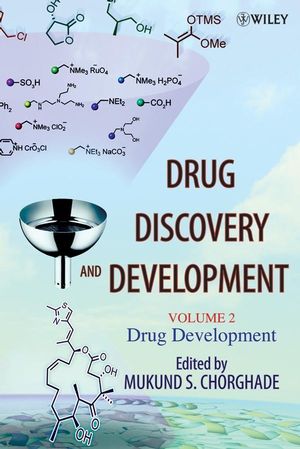Drug Discovery and Development, Volume 2: Drug DevelopmentISBN: 978-0-471-39847-9
Hardcover
400 pages
August 2007
 This is a Print-on-Demand title. It will be printed specifically to fill your order. Please allow an additional 15-20 days delivery time. The book is not returnable.
|
||||||
Preface.
17 Bioactive Molecules in Medicinal Plants: A Perspective on Their Therapeutic Action (S. C. Taneja and G. N. Qazi).
17.1 Introduction.
17.2 Evolutionary Relationships Among Plants and Humans.
17.3 Traditional Wisdom.
17.4 Unique Libraries for Plants.
17.5 Drugs and Bioactive Molecules from Plants.
17.6 Synergism in Herbal Formulations.
17.7 Interactions Between Modern Drugs and Natural Products.
17.8 Bioavailability and Bioeffi cacy Enhancers.
17.9 Combination Therapies in Modern Drugs.
17.10 Role of Developments in Technologies and Analytical Tools.
17.11 Herbal Medicine: The Best Possible Route to Health Care.
References.
18 Natural Products as an Inspiration for the Discovery of New High-Throughput Chemical Synthesis Tools (Steven V. Ley, Ian R. Baxendale, Deborah A. Longbottom, and Rebecca M. Myers).
18.1 Introduction.
18.2 Solid-Supported Reagents as Tools in Natural Product Synthesis.
18.3 Multistep Use of Supported Reagents in Natural Product Synthesis.
18.4 Conclusions.
References.
19 Insulin Sensitizers: Emerging Therapeutics (Braj B. Lohray and Vidya B. Lohray).
19.1 Introduction.
19.2 Therapeutic Interventions.
19.3 Discovery of Insulin Sensitizers.
19.4 Journey Toward New Drugs.
19.5 Conclusions.
References.
20 Criteria for Industrial Readiness of Chiral Catalysis Technology for the Synthesis of Pharmaceuticals (Raymond McCague and Ian C. Lennon).
20.1 Introduction.
20.2 Criteria for Technology Readiness.
20.3 Examples of Industrially Ready Chiral Catalytic Technologies and Their Application.
20.4 How Industrially Ready Technology Can Deliver Commercial Advantages.
20.5 Conclusions.
References.
21 Enantioselective Synthesis of Propargyl Alcohols as Multifunctional Synthons (J. S. Yadav and S. Chandrasekhar).
21.1 Introduction, 141
21.2 Asymmetric Reduction of Prochiral α, β-Alkynyl Ketones, 142
21.3 Addition of Acetylenic Anion to Carbonyl Carbon, 148
21.4 Desymmetrization and Enzymatic Strategies for Chiral Propargyl Alcohol Synthesis.
21.5 β-Elimination Strategy and Miscellaneous Approaches.
21.6 Conclusions.
References.
22 Carbohydrates: From Chirons to Mimics (G. V. M. Sharma and Palakodety Radha Krishna).
22.1 Introduction.
22.2 Synthetic Strategies for C-Glycosides.
22.3 Synthetic Strategies for Carbon-Linked Disaccharides and Pseudosaccharides.
References.
23 Meeting the Challenges of Process Development and Scale-up of Active Pharmaceutical Ingredients (Yatendra Kumar and B. Vijayaraghavan).
23.1 Introduction.
23.2 Process Development Cycle.
23.3 Conclusions.
References.
24 Importance of Polymorphs and Salts in the Pharmaceutical Industry (Bipin Pandey, Vidya B. Lohray, and Braj B. Lohray).
24.1 Introduction.
24.2 Drug Discovery and Development.
24.3 Salt Selection.
24.4 Pseudopolymorphs.
24.5 Analytical Tools.
24.6 Process Development.
24.7 Formulation Development.
24.8 Regulatory Concerns.
24.9 Patent Implications.
24.10 Predictions and Uncertainties.
24.11 Conclusions.
References.
25 Role of Outsourcing in Drug Manufacture (Peter Pollak).
25.1 Introduction.
25.2 Outsourcing in the Pharmaceutical Industry.
References.
26 Regulation-Driven Process Chemistry (Shrikant V. Kulkarni).
26.1 Introduction.
26.2 Chemical Industry Regulatory Guidelines.
26.3 Manufacturing Techniques in Process Chemistry.
26.4 Effects of Pesticide Industry Regulation.
26.5 Efforts at Denitrifi cation.
26.6 Evolution to Green Chemistry.
References.
27 Chemical Process Scale-up Tools: Mixing Calculations, Statistical Design of Experiments, and Automated Laboratory Reactors (Andrei A. Zlota).
27.1 Chemical Process Scale-up Challenges.
27.2 Case Study: Development of an Active Pharmaceutical Ingredient Crystallization Process.
27.3 Case Study: Determination of a Scale-up Factor for the Bourne III Reactive System.
27.4 Conclusions.
References and Notes.
28 Library Quality Metrics (Richard L. Wife and Johan Tijhuis).
28.1 Drug Discovery and Development.
28.2 Compound Libraries.
28.3 Library Metrics.
28.4 Conclusions.
29 Tying a GABA from Copenhagen to Chicago: The Chemistry of Tiagabine (Mukund S. Chorghade, Mahendra N. Deshpande, and Richard J. Pariza).
29.1 Introduction.
29.2 Synthesis of Symmetrical Analogs: Tiagabine.
29.3 Synthesis of Unsymmetrical Analogs: Desmethyltiagabine.
29.3.1 Syntheses of Regioisomers of Tiagabine.
29.3.2 Human Metabolite of Tiagabine: 5-Hydroxytiagabine.
29.4 Attempted Biomimetic Synthesis of 5-Hydroxytiagabine.
29.5 Oxidative Degradation Products of Tiagabine.
29.6 Metalloporphyrins as Chemical Mimics of Cytochrome P450 Systems.
References.
30 Building Contract Research Businesses Based on Integration of Basic and Applied Research (Mukund S. Chorghade, Mukund K. Gurjar, C. V. Ramana, and Sreenivas Punna).
30.1 Introduction.
30.2 Solving Real-World Problems.
30.3 Synthesis of Pharmaceutically Relevant Chiral Tetrahydrofurans.
30.4 Drugs for the Treatment of Skin Disorders.
30.5 Conclusions.
References.
31 Principles and Practice of Clinical Drug Development (Colin Scott).
31.1 Introduction.
31.2 History of Ethical Medical Research.
31.3 History of the Regulation of Medical Research.
31.4 Preclinical Development.
31.5 Clinical Development.
31.6 Conclusions.
Index.



